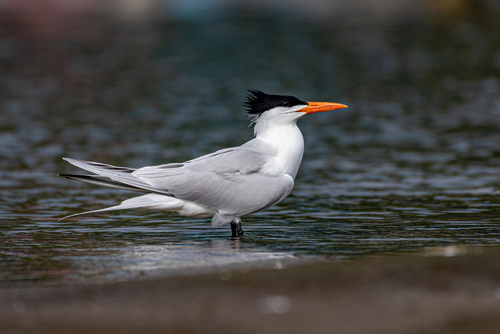
Royal Tern
The Royal Tern (*Thalasseus maximus*) is a large, elegant seabird known for its striking appearance and impressive aerial displays. It plays a significant role in coastal ecosystems as a predator of small fish. These birds are widely distributed across the Americas and West Africa. They are not typically associated with strong cultural symbolism, but their presence is often valued by birdwatchers and nature enthusiasts for their beauty and grace.
45-50 cm
Length
125-135 cm
Wingspan
Least Concern
Conservation Status
Distribution
Royal Terns are found along the coasts of North and South America, from California to Argentina on the Pacific side and from New Jersey to Argentina on the Atlantic. They also inhabit the West African coast from Mauritania to Namibia. Migratory, with northern populations moving south in winter.
Lifespan
Up to 17 years recorded in the wild.
Royal Tern's Habitat
Habitat Types
Coastal beaches, Estuaries, Lagoons, Salt marshes, Sandy islands
Climate Zones
Tropical, Subtropical, Temperate
Adaptations
Royal Terns have streamlined bodies and long, pointed wings for efficient flight over water. Their strong, sharp bills are well-suited for catching fish. They have salt glands above their eyes to excrete excess salt, an essential adaptation for a marine bird.
Variations
Two subspecies are generally recognized: *T. m. maximus* (Americas) and *T. m. albididorsalis* (West Africa). The African subspecies is slightly smaller and has a paler gray back.
Appearance
Breeding Plumage
Breeding adults have a black cap, white body, and gray wings. Non-breeding adults and juveniles have a white forehead and a patchy black cap.
Seasonal Feather Changes
The black cap becomes more extensive and solid during the breeding season.
Sex Based Plumage Differences
Minimal; males and females have similar plumage.
Notable Features
Bright orange-red bill, Shaggy black crest (more prominent during breeding), Long, forked tail
Diet and Feeding
Primary Foods
Small fish, Shrimp, Crabs
Foraging Behavior
Royal Terns primarily feed by plunge-diving. They fly over the water, spot prey near the surface, and then dive headfirst to capture it.
Specializations
Their excellent vision and aerodynamic bodies allow for precise and effective dives.
Seasonal Diet Variations
Diet may vary slightly depending on the availability of prey in different regions and seasons, but fish remain the primary food source year-round.
Behavior
Social Structure
Highly social; breeds in dense colonies, often with other tern species. Forages in flocks, sometimes large ones.
Communication
Loud, harsh 'keer' calls, Rapid chattering during courtship, Begging calls by chicks
Migration
Many populations are migratory, moving south from their breeding grounds in the winter. Some populations are resident or only make short-distance movements.
Territorial or Group Behaviors
Royal Terns are highly territorial within the breeding colony, defending a small area around their nest. Outside the breeding season, they are less territorial and often forage in groups.
Conservation
Threats
Habitat loss and degradation (coastal development), Disturbance at nesting sites (human activity, predators), Pollution (oil spills, plastic ingestion), Climate change (sea-level rise, altered prey distribution)
Protection Programs
Protection of nesting colonies, Habitat restoration projects, Monitoring of populations
Local National Laws
Protected under the Migratory Bird Treaty Act in the United States and similar legislation in other countries.
Population Trend
Stable
Population Estimates
Global population estimated to be around 300,000 individuals.
Interesting Facts
Royal Terns are among the largest tern species.
Their size distinguishes them from many other terns, which are generally smaller and more delicate.
They can live for over 15 years.
This relatively long lifespan is impressive for a seabird that faces numerous threats.
Their colonies can contain thousands of nests.
This dense nesting behavior helps protect against predators but also makes them vulnerable to disturbances.
Faqs about Royal Tern
What is the difference between a Royal Tern and a Caspian Tern?
Royal Terns have a thinner, orange-red bill, and a shaggier crest, while Caspian Terns have a thicker, deeper red bill and a smoother black cap. Caspian Terns are also larger.
Do Royal Terns mate for life?
Pair bonds are generally maintained for the breeding season, but long-term pair fidelity is not well-studied.
How deep can Royal Terns dive?
They typically plunge-dive to depths of less than 1 meter.
Are Royal Terns endangered?
No. Royal Terns are classified as 'Least Concern' by the IUCN, indicating that the global population is relatively stable.
What eats a Royal Tern?
Adult Royal Terns have few natural predators, but eggs and chicks may be preyed upon by gulls, raptors, rats, foxes, and other opportunistic predators.
Copyright @ Nature Style Limited. All Rights Reserved.
 English
English